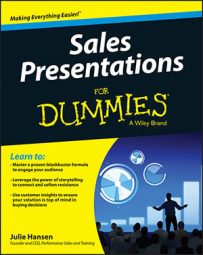Each topic you cover must contribute to creating a sense of urgency within your prospect to get the problem resolved and get it resolved now. Not someday. Watching some salespeople deliver the body of a presentation would make one think it didn't matter one way or the other if the salesperson received her commission next month or next year.
Although more traditional presentation structures place the emphasis on creating urgency in the closing, if you haven't primed the pump in the body, your closing can be like trying to get water out of a dry well. In order to move your prospect from where she is now to where you want her to go, you need to create tension by adding complications. Just like in the movies where a hero is at first reluctant to get involved — up until the situation has gotten so out of control and the tension so great that she is eventually compelled to take action, your prospect needs to have a compelling reason to take action as well.
Even though signing a contract may not be the heroic actions people have come to expect in the movies, it doesn't make your prospect's task any easier. If you're asking your prospect to change her perspective, risk her reputation, or change the way she's done something for 20 years, simply parading a bunch of evidence out and asking her to evaluate it isn't going to cut it.
People are prone to homeostasis — the desire to stay put, especially if the problem doesn't appear that bad to your prospect. Although it may appear bad to you, remember that your prospect has been living with the problem, adapted to it, and likely put a few bandages on it. Even a rut can be pretty comfortable if you decorate it nicely. You must give your prospect a strong nudge to get out of her comfort zone if you want her to take action at the end of your presentation.
The closing is too long to wait to start to close. Build a persuasive case and start to increase the tension in the body of your presentation to make your closing self-evident.
Amplifying the tension
In your presentation's body you must continue to increase the tension by exploring with the prospect the impact of either not addressing their challenge or using a competitor to address the prospect's challenge. Ratcheting up the tension creates urgency within your prospect to solve the problem, which is especially important when prospects have multiple priorities or challenges and limited time and resources, or if you're battling against the status quo.
By widening the gap between pain and relief and exploring the impact of not making a change — or of making the wrong change — you can increase your prospect's attention, keep her engaged, improve message recall, and speed up the sales cycle.
Building tension without getting tense
Many new sales philosophies embrace the idea of creating tension in order to move a prospect off of the tough to crack "no change" position. If you cringe at the thought of talking to your prospect about the impact of not making a change or the pitfalls of going with a competitor's product, remember that you don't have to deliver this news with ominous organ music playing in the background or while standing on a soapbox.
Although increasing the tension can be uncomfortable, in reality you're simply exploring consequences. The consequences of no decision or a bad decision are real and sometimes quite painful. Just as in the legal world, ignorance of the law of consequences doesn't make a person immune from their effects. Supporting your prospect's denial ultimately doesn't serve either you or your prospect.
The fact is that more people are willing to take a risk to avoid pain than to seize an opportunity. In fact, recent research on the topic indicates that people have a three times stronger preference to avoid loss than to achieve gain. If you're still uncomfortable, ask yourself the following three questions to determine whether addressing the consequences makes sense for you:
Are there negative consequences to indecision or a wrong decision?
Can you help your prospect avoid potential negative consequences?
Is your prospect able to take the steps necessary to avoid negative consequences?
If you can answer yes to all three of these questions, you owe it to your prospect — and yourself — to speak out.

